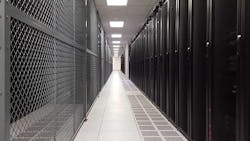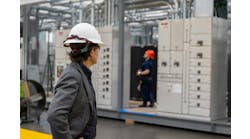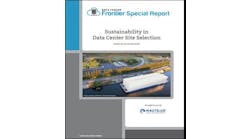The Eight Trends That Will Shape the Data Center Industry in 2022
What lies ahead for the data center industry in 2022? At Data Center Frontier our eyes are on the horizon, and we’re constantly tracking the trends that matter. Our crystal ball did pretty well last year, so it’s time to look ahead at what’s in store for 2022.
We’ve identified eight themes that we believe will shape the data center business this year. The overarching theme is dealing with the challenges of growth and the data center industry’s vital role in a digital society, as well as the urgent need for progress on climate change. We’ll be writing in more depth about many of these trends, but this list provides a high-level view of the topics that we believe will be most relevant in 2022.
1. Climate Change Shapes Site Selection
The real estate mantra of “location, location, location” will be more important than ever in 2022 and beyond. Choosing the right location for a data center campus has never been simple. But site selection is becoming a strategic priority as cloud builders seek larger chunks of real estate while balancing a multitude of tensions – climate concerns, scarcity of key resources like power and water, and growing community interest in the local impact of Internet infrastructure.
We start with site selection because it is an important thread running through many of our other trends for 2022. Energy, growth of second-tier and edge infrastructure, and community unease about data center development are meaningful trends, as we will discuss shortly. All of them raise the bar for site selection, especially as data centers get larger and more numerous.
A key issue is climate change, which is altering the status quo in both real estate and energy sourcing. Some of the most important data center markets will need to address concerns about water scarcity and their supply of renewable energy.
“Environmental considerations will likely impact site selection, benefiting markets with an abundance of clean energy like Montreal and Hillsboro, Oregon, and adding challenges to markets with tighter resource restrictions like water conservation in Phoenix, Las Vegas and Salt Lake City,” CBRE writes in its 2022 outlook. “Power constraints will remain the biggest threat to new developments in markets like Northern Virginia and Silicon Valley.”
As we see more climate-powered disasters, we will also begin to see how climate change is moving the goalposts, as locations that once were ideal for data centers may experience drought, larger storms, and “rain bomb” weather events redefine the historical boundaries of flood zones and wildfire risk.
These concerns are reflected in a recent survey of data center users by Uptime Institute on climate risk. “One in 10 data center operators now sees a dramatic increase in the risk to their facilities — a figure that suggests many hundreds of billions of dollars of data center assets are currently believed to be at risk by those who are managing them,” Uptime notes. “Insurers, investors and customers are taking note.”
Meanwhile, operators are building larger data centers and campuses, which require more acreage. For Microsoft, new campuses may incorporate additional acreage to meet climate priorities. At a new campus in northern Holland, Microsoft will “construct a lowland forested area around the datacenter as well as forested wetlands, which are highly saturated with water and vegetation suited for water filtration to naturally process storm water and runoff,” said Noelle Walsh, Corporate VP, Cloud Ops and Innovation at Microsoft.
In our 2020 Eight Trends forecast, we anticipated the rise of data center districts that provide an efficient focal point for infrastructure development. That was a “miss” in 2020, but there are signs that officials in some regions are working harder to guide data center development. A leading example is China, which has outlined a vision for four regional “mega-clusters” of data centers to concentrate energy and land use.
2. Resiliency and Uptime Take Center Stage
Uptime is always job one for the data center industry. As more companies embrace hybrid infrastructure, uptime is becoming more complex, requiring backup and failover strategies that span cloud, colo, on-premise facilities and edge infrastructure.
In 2021, a series of major cloud reliability incidents hobbled Internet services, including a May outage for CDN provider Fastly, October downtime for all Facebook sites, and a lengthy December outage for Amazon Web Services.
“As the world becomes more dependent on IT services, reliability will receive greater scrutiny and calls for further improvements,” said Uptime Institute in its annual outage report. “The number of outages has declined, but the consequences continue to worsen. … Applications are often composed of many disparate, distributed components and services. As a result, IT outages have become less binary — failures are often partial and dependent on user configurations.”
The Uptime report noted that a technical problem at Fastly (a “relatively little-known internet service company”) led to a global disruption in Internet services affecting thousands of sites and cloud services. “For many businesses, it demonstrated the lack of adequate visibility they have into their cloud providers’ platforms,” said Uptime.
On an operational level, many users will optimize their IT architectures to better withstand third-party outages – at either the cloud, the core, or the edge. An outage’s impact is always dependent on the provider and location. The global Facebook outage in October was a meaningful interruption for many small businesses, while the AWS downtime affected many SaaS services.
Even some veteran cloud watchers were unsettled by the December AWS incident and its ripple effects.
“The extreme impact of (the Dec. 4) outage could be thought of as a natural consequence of the quality and popularity of AWS’s product,” wrote Corey Quinn, Chief Cloud Economist at The Duckbill Group, writing in The Information.
“Collectively, we’re dealing with a problem that goes beyond any one company,” Quinn added. “As our digital infrastructure has come to rely on just a small handful of businesses, we’ve all been slow to wake up to the risk we’ve taken on.”
3. M&A Shifts to the Data Center Supply Chain
Supply chain pressures are very real for the data center industry. Most operators say they have not seen major project delays, using a variety of strategies to manage their supply chain risk. But some industry analysts believe delays in equipment and shortages of construction labor will be felt more acutely in 2022.
How Data Centers Are Navigating the Supply Chain Crisis (Image: Shutterstock)
“Supply chain disruptions could impair data center development and delay the delivery of new supply, CBRE said in its 2022 forecast. “As uncertainty looms amid pandemic-related restrictions for markets outside of the U.S., particularly in Asia-Pacific, material shortages and increased shipping delays into U.S. ports have the potential to delay new facility developments and impact refresh cycles of data centers. These delays could drive up costs, potentially raising rents in affected markets 4%-6%.”
In a business environment facing delays and cost hikes, how does a company improve its position? M&A can be an important tool. In 2021 “supply chain deals became commonplace as companies worked to gain greater control over operations,” according to Supply Chain Dive. “Many deals came as shippers sought to integrate vertically, acquiring suppliers or technology that would make them more competitive.”
We saw a hint of this in December when Iron Mountain announced plans to acquire ITRenew, which decommissions data centers and recycles IT assets. As recycling becomes a more important component of sustainability, the deal boosts Iron Mountain’s position in IT asset lifecycle management. But it also creates possibilities in procurement, as ITRenew resells pre-owned hardware through its Sesame line of rack-scale solutions.
Data center operators and their financial backers have access to enormous financial resources, as seen in the M&A binge in 2021. Expect to see some players wield that financial strength to secure control of critical components in their data center deployments, either through acquisitions or creative joint ventures or partnerships.
4. Investment Accelerates in Regional Markets and Edge
An influx of global capital has propelled the growth of digital infrastructure, as well as the wave of M&A activity that has transformed the data center industry. Much of this investment has been focused on adding capacity in the largest global markets, like Ashburn, Frankfurt, London and Dublin.
In 2022, the capital infusion will extend to regional markets and service providers specializing in “second-tier” cities and edge computing. There were clear signs of this in 2021, and we’ll see even more significant growth and investment in 2022, along with a high probability of acquisitions. Three headlines from December highlight this shift:
- Global private equity firm The Carlyle Group acquired Involta, a regional data center provider based in Cedar Rapids, Iowa that operates 12 facilities in the Midwest. Carlyle has $293 billion in assets under management and helped found CoreSite (remember CRG West?). This deal is a sign that smart money sees opportunity in regional digital infrastructure.
- Flexential raised $2.1 billion to accelerate its growth strategy, and will use the money to deploy highly-sustainable data centers and enter new markets. Flexential is the latest data center company to use asset-backed securities to raise funds, including a green bond component.
- Amazon Web Services announced plans to enhance its edge computing network by building AWS Local Zones in 30 new locations.
Meanwhile, regional chains are raising funds and bulking up. DataBank, the colo and edge computing brand for DigitalBridge, used secured notes to raise nearly $1 billion to deploy new data center capacity, and then initiated 10 data center expansion projects in six months. EdgeConneX, which is now backed by global infrastructure fund EQT, added nearly 20M megawatts (MWs) of new capacity across six regional markets. Media reports suggest Cologix is prepping a $1 billion-plus sale of secured notes to fund growth.
Why is money flowing into second-tier markets? Demand for online services is strong everywhere, and the pandemic has reinforced the case for more distributed IT infrastructure. Meanwhile, core markets are getting crowded and competitive, and new investors continue to seek access to attractive returns in digital infrastructure. Regional markets with business growth and clean energy will be clear winners, along with providers with strong teams and good networks.
5. Liquid Cooling Gains Wider Adoption
I’ve made this prediction before, most notably in our 2019 Eight Trends forecast. But it appears the data center industry is finally poised for broader adoption of liquid cooling, and we will see significant strides in this direction in 2022. Several factors are prompting a reassessment of cooling, including powerful new hardware for AI workloads, growing pressure to eliminate water use in cooling servers, and major progress in enabling liquid cooling from cloud and colocation providers, as well as server and chip vendors.
Christian Belady, distinguished engineer and vice president of Microsoft’s datacenter advanced development group, stands next to a two-phase immersion cooling tank at a Microsoft data center. (Photo: Microsoft)
The biggest nudge is coming from Microsoft, which has begun using immersion-cooled servers in production, and believes two-phase immersion promises major gains in density and efficiency. “Because of the efficiencies in both power and cooling that liquid cooling affords us, it unlocks new potential for data center rack design,” said Christian Belady, distinguished engineer and vice president of Microsoft’s datacenter advanced development group. “We’re only at the beginning of the density curve. We’re really bullish on the technology.”
Microsoft isn’t alone, as the two largest multi-tenant data center providers, Equinix and Digital Realty, are also preparing for broader use of liquid cooling.
“We have an opportunity to start a network effect for liquid cooling, and it starts with us bringing liquid cooling into our facilities in a scalable way with Open19,” said Zac Smith, the Managing Director for Equinix Metal, which plans to be the “anchor tenant” for liquid cooling deployments in Equinix data centers. Meanwhile, Digital Realty is now offering liquid-cooled bare metal servers at its data center in Singapore, as well as an immersion lab in Ashburn.
Some believe edge computing will provide additional momentum for liquid cooling.
“Air cooling is often unsuitable for edge deployments, which are frequently located in urbanized and harsh locations where dust and other contaminants abound,” Steven Carlini, VP, Innovation and Data Center for Schneider Electric. “Blowing such material around an unmanned or remote edge data center is far from ideal, and even if filters were attached, the task of frequent replacement and servicing remains a key challenge – especially where cost and circularity are concerned. … New liquid cooled architectures may emerge for the edge at scale. Whether that involves direct-to-chip liquid cooling or chassis-based immersive cooling is yet to be seen.”
6. Data Centers Confront Community Resistance
Everyone wants great Internet in their home office, but they’re not as enthused about having a data center across the street. There’s a growing narrative that data centers are undesirable neighbors, and if this sentiment continues to build, it could slow growth in key markets.
Back in our 2018 Eight Trends Forecast, we predicted a rise in data center controversies related to NIMBY (Not in My Backyard) resistance from community activism. That prediction was early, but the trend is clearly here as we enter 2022, as we see in these headlines:
- Drought-Stricken Communities Push Back Against Data Centers
- How Facebook Secretly Lobbied to Build Holland’s Biggest Data Center
- Data Centers Are Pushing Ireland’s Electric Grid to the Brink
- The Dalles Sues to Keep Google’s Water Use A Secret
This media coverage often tells only half the story, and concerns about “data centers” have been amplified by the surge in sustainability-challenged bitcoin mining operations in the past year as capacity has shifted from China to the U.S. (particularly in upstate New York and Texas).
Community resistance is becoming a real challenge in some of the most important data center markets. That includes Northern Virginia, where data center development is creating heated debate in Prince William County, an important expansion market. New projects are meeting resistance in Loudoun County as developers seek to build data centers on sites bordering residential developments.
This is an industry problem. Data center operators need to be good neighbors, and explain why their giant cloud campuses will be a benefit to the community, and not a noise problem, eyesore or drain on precious resources.
In some cases, operators may need to change their practices to meet this challenge, especially when it comes to transparency about their use of water and power, and the secrecy around “codename” projects. In many other cases, data centers need to do a better job articulating data centers’ critical role in boosting local economies through connectivity, taxes and community support. Groups like Host in Ireland and the Dutch Data Center Association are already on the front lines on this effort.
The bottom line: In 2022 it will be harder to predict whether plans for a new data center campus will be stalled or derailed by community resistance, and every developer should have a strategy to productively address the questions and concerns of local residents.
7. Data and Energy Forge Deeper Connections
It’s been 10 years since the data center team at Microsoft laid out a vision for “data plants” that integrate computing and renewable electricity in new ways. We first highlighted this trend in our Eight Trends for 2020, just prior to Microsoft’s initiative to eliminate diesel fuel and experiments with hydrogen fuel cells , and plans by Switch and Google to adopt utility-scale energy storage into their operations.
As we enter 2022, the intersection of data center energy will enter a new phase, driven by demand for renewably-powered data centers and the deep pockets of global investors.
Yondr Group will develop renewable energy projects to support its data center campuses, taking a direct role in the power generation business. Yondr is also working with BritishVolt, a maker lithium-ion batteries, on energy storage options for data centers.
EdgeConneX has recently outlined plans to develop a nationwide network of charging depots for electric vehicles (EVs), which will combine edge data centers with 5G connectivity and EV charging stations and maintenance bays, along with a driver lounge with amenities including food, rest areas and even office space. The program is targeting corporate fleets, including logistics companies and rideshare services.
The data/energy integration is also being driven by power constraints in leading markets, including “bring your own power” strategies. Amsterdam, Frankfurt and Singapore have all slowed data center development as they study the best way to manage available supplies of power and land. Ireland’s electricity regulator is “tasking data centers with bringing some solutions to the table,” for developments in power-strapped metros.
Microgrids are shaping up as a key enabler of on-site generation and energy diversification. A microgrid provides access to multiple energy sources – the utility grid, energy storage, generators, solar or wind energy – and allow data centers can operate independently of the grid during outages and times of crisis. Data center microgrids can also integrate renewable energy sources, which can reduce carbon emissions.
“A hybrid electricity solution, backed by microgrids, can bridge the gap between our ultimate net-zero goals and the current market’s shortcomings,” said John Gould of Enchanted Rock, a provider of microgrid solutions.
Carsten Baumann, director of Strategic Initiatives at Schneider Electric, noted that microgrids can also enable more granular management of the cost of power, a major component of data centers’ bottom line. The ability to integrate new generation sources and energy storage can create an energy arbitrage system, said Baumann, in which data centers can source the cheapest power option at any time of day.
8. Making Sense of The Metaverse Movement
Will metaverse platforms turn out to be incremental improvements upon current virtual reality games and services? Or will metaverse aspirants deliver fully-immersive VR and AR worlds that users love and use?
Put another way: What type of server, storage and network infrastructure will be needed to make this work?
We’ll learn more about this in 2022. Whatever form they take, metaverse technologies are bound to be resource-intensive applications, as we noted in last month’s DCF Roundtable (The Metaverse Will Need Lot of Data Centers). Intel expanded on this in December.
“We need several orders of magnitude more powerful computing capability, accessible at much lower latencies across a multitude of device form factors,” said Raja Koduri, senior vice president and general manager of the Accelerated Computing Systems and Graphics Group at Intel. “To enable these capabilities at scale, the entire plumbing of the internet will need major upgrades.
“Truly persistent and immersive computing, at scale and accessible by billions of humans in real time, will require even more: a 1,000-times increase in computational efficiency from today’s state of the art,” Koduri shares in a blog post. “Many advances across transistors, packaging, memory and interconnect that will help are in the pipeline.”
“(The metaverse will) need several orders of magnitude more powerful computing capability, accessible at much lower latencies across a multitude of device form factors. To enable these capabilities at scale, the entire plumbing of the internet will need major upgrades.”
Raja Koduri, Intel
“The infrastructure to support a concept as bold as the Metaverse cannot be limited to a small number of physical locations,” said Phillip Marangella, Chief Marketing Officer at EdgeConneX, in a DCF Voices column. “It needs to be extensive even as it needs to feel local and exhibit ultra-low latency.”
Venture capitalist Matthew Ball predicts that a functioning metaverse ecosystem will likely require a combination of cloud capacity, more powerful local devices, edge computing networks, and perhaps even marketplaces for real-time distributed compute power to provision horsepower as needed.
In some cases, the evolution of the metaverse will reinforce other trends we are seeing. “The data center industry doesn’t know the future of the metaverse, but they can predictably assume they’ll need sustainable, future-proof liquid cooling technology,” said Kevin Facinelli, Group President for Nortek Data Center Cooling, in the December DCF roundtable .
What Else We Are Watching
Here are a few other trends that were contenders for the list, and we’ll be watching closely in 2021:
- Satellites and Digital Infrastructure: As we’ve noted in our coverage of “New Space,” low-earth orbit (LEO) satellites are creating new applications for imaging and Internet access, and connecting with data centers and cloud platforms. This trend will continue to gain traction in 2022.
- Blockchain and Web3 Growth: It’s fashionable these days to be skeptical about “Web3” and blockchain hype. But there’s plenty of smart money and smart technology in play here. As much as folks may like to think they are reinventing the wheel, much of Web3, NFTs and DeFi (decentralized finance) apps rely on traditional cloud and data center infrastructure. What to watch for: A decision from Washington on how blockchain tech will be taxed and regulated, which could create market clarity and unleash investment and adoption.
- More Intense AI Infrastructure: We’ve talked lots over the years about AI and its impact on data gravity. But goodness gracious, some of these AI models are getting huge, and are translating into new hardware and even larger datasets.
Want to stay on top of these trends? Follow us on Twitter and Facebook, connect with me on LinkedIn, and sign up for our weekly newspaper using the form below








